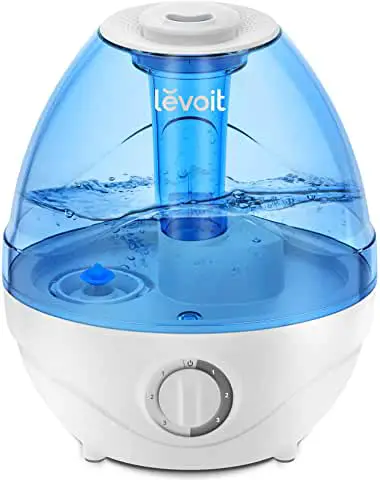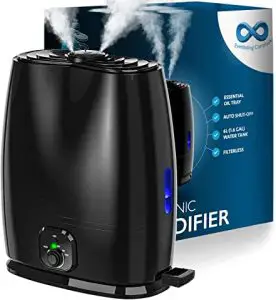Humidifiers can alleviate the symptoms of cracked lips, bloody noses, and dry sinuses that are sometimes associated with dry indoor air. Other respiratory conditions may also benefit from the use of cool-mist humidifiers.
Be aware: Humidifiers are essential, but if they aren’t properly maintained or if the levels of humidity are too high, they might cause illness. Keeping your humidifier clean and checking the humidity levels are essential if you use one.
Bacteria and mold can grow in humidifiers that have become soiled. Before using a humidifier, seek the advice of your doctor if you suffer from allergies or asthma.
No products found.
Problems associated with humidifiers
While humidifiers are known for their many benefits, there are various humidifier risks. Below are some problems that may be associated with humidifiers.
You should of course rule out the possibility that they are not caused by other factors in your house such dust or viruses from other sources. These problems include:
Coughs and colds that keep coming back
You’ve got a child or other family member who keeps getting coughs and colds. The humidifier may need a thorough cleaning. Coughs and colds are often mistaken for the latest cold virus to sweep through the local school.
But they could be due to an allergic reaction to anything the humidifier is emitting. The humidifier could become infected with microorganisms brought in by someone else and spread throughout the house.
A baby’s immune system may not be able to handle this as well as typical children or adults. Every time a member of the family has recovered from a cough or cold, it’s a good idea to clean out the humidifier and replace the filter to prevent the growth of bacteria.
Those who have a respiratory infection should stay away from the baby and turn off the humidifier in the room.
Use your humidifier in moderation, even if you are unwell or weary of having dry sinuses. Nowadays, many cheap models do not feature humidistats to let you know the humidity level in the atmosphere.
Running a humidifier in your room for many hours can provide a breeding ground for microbes, just like with a dirty humidifier. Moisture can stick to the drywall in very humid rooms, posing a lasting risk to the room’s structural integrity.
Similarly, if you run your humidifier for a longer period of time, you may end up with a mold issue. If you do not already have one, a humidistat is a good investment to make sure your humidifier is running at a safe temperature.
White Dust
Humidifier use might leave some white film on the furniture. Minerals in the water could be the source of the white dust in your humidifier. These minerals have accumulated and, in some cases, have been spread through the air by the humidifier.
Depending on the water’s mineral content, these particles might be harmful or harmless. The presence of this white dust on furniture, especially in a setting with high humidity, might promote the spread of bacteria.
Fill the humidifier with distilled water to avoid the buildup of white dust. You can find traces of minerals in normal, unfiltered water from the extracted soil.
In order to assure that the user receives only clean water, the distillation and demineralization procedure removes these trace minerals. For the sake of your child’s health, it’s ideal to use water that’s appropriate for the task at hand.
Spilling water
Humidifiers can leak for a variety of reasons. Especially if there are children in the family, these issues must be addressed for safety’s sake. Unattended water spills can cause youngsters to slide and get injured.
These accidents are hazardous for infants and toddlers, who are more likely to get hurt. Overfilling a humidifier will cause it to leak.
In addition, if there’s a bent or clogged drainage pipe, it can cause a leak. A clogged evaporator pad is another possible cause of a spill; this typically occurs when the white dust accumulates on the pad.
The best course of action is to call in a professional if a humidifier continues to leak water and the problem cannot be pinpointed. Water can create spills, but it can also lead to electrocution.
Burns
Burns are the most prevalent type of injury caused by humidifiers. Warm mist varieties, which spread water vapor as steam, will benefit most.
Residents in arid and cold regions prefer this type because it can control temperature and humidity.
These are also the most popular because they are inexpensive and easily available. As a result, the conversion of water to steam needs a significant amount of energy.
If you adjust the temperature too high, the steam can be hot enough to cause burns, making the unit dangerous.
A nosy toddler could get hurt if they come too close to the humidifier. As a result, go with a device that doesn’t require you to heat the water in order to create vapor.
Often, experts say that ultrasonic humidifiers, which may make more vapor than steam humidifiers but are safer for kids, are the best.
No products found.
Mitigating the Risks of Humidifiers
One of the best ways to mitigate the risks associated with using humidifiers is through proper cleaning and maintenance of your humidifier. Understanding how humidifiers work can also guide you on their maintenance process.
What are some of the useful steps to take when cleaning your humidifier?
The best ways to clean your humidifier
Follow the manufacturer’s directions to keep humidifiers free of bacteria and mold. These are some helpful hints for using a portable humidifier:
Replace old humidifiers if necessary
Humidifiers can accumulate clogs that are hard to clean and serve as breeding grounds for microorganisms over time.
If your humidifier has served its time, bid it goodbye and replace it with a new functional humidifier to avoid the risks that come with dysfunctional humidifier.
Change the water in your humidifier frequently
You should clean your humidifiers regularly to avoid the buildup of film or other residues. If you’re using ultrasonic or cool-mist models, make sure to empty the tanks daily, dry the interior surfaces, and refill with fresh water. First, unplug the device.
Preparing humidifiers for storage
Before storing humidifiers for the winter, make sure they are clean and drained. You’ll need to clean them once more before putting them away for the cold months. Don’t keep anything you don’t need anymore, like filters, cassettes, or cartridges.
Use a damp cloth to wipe down humidifiers every three days
Before cleaning the humidifier, unplug it from the wall outlet. Use a 3 percent hydrogen peroxide solution to remove film or mineral deposits from the humidifier’s tank or other components. Some producers may recommend the use of chlorine bleach or other disinfectants.
No products found.
Change humidifier filters frequently
Make sure you change the humidifier filter at least once a month, and more frequently if it is filthy. Alternately, make sure that you change your central heating and cooling system’s filter on a regular basis.
Always rinse the tank after cleaning it
As a result, there will be no emission of hazardous substances into the atmosphere or ingested.
Keep the space around humidifiers free of moisture
If the area around a humidifier becomes wet or moist, turn the humidifier down or lower the frequency with which it is used.
Ensure that the items in the space that are likely to retain moisture are well aired and dry. This includes tablecloths, carpeting, windows, and draperies.
Follow instructions for central humidifiers
The humidifier installed in the central heating and cooling system should be well-maintained according to the instructions in the owner’s manual or by a heating and air conditioning professional.
Using demineralized or distilled water
It is possible that the minerals in your tap water can form deposits in the humidifier’s interior part, which will encourage the growth of bacteria.
The white dust on your furniture is generally the result of these minerals being discharged into the air.
In addition, inhaling the air can cause you to ingest the minerals. The mineral concentration of demineralized or distilled water is significantly lower than tap water. Also, if indicated by the manufacturer, use demineralization filters or cartridges.
No products found.
Summary on humidifiers
While humidifiers can pose a few concerns, the majority of the problems with these gadgets are dependent on the humidifier being overused or misused or if you don’t clean it properly.
Learning how to clean your humidifier will improve its life span while ensuring you reap the full benefits of a humidifier.
The most common cause of humidifier fever is a malfunctioning machine, not the humidifying process itself. They may warm and moisten the air in a room if you place them correctly and of the appropriate size.
Reduced transmission of cold germs and relief from symptoms such as dry throats and skin issues can all result from this.
The secret to having your humidifier working at optimum is proper and regular maintenance and keeping it super clean.


